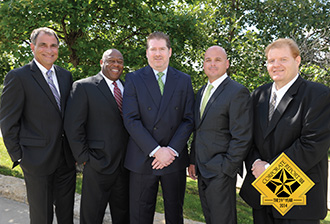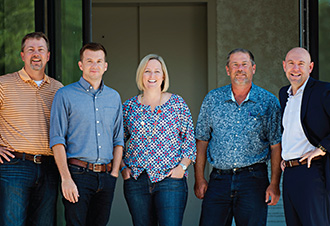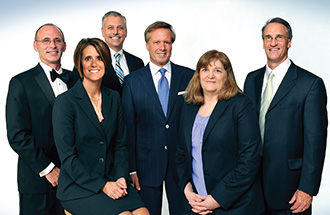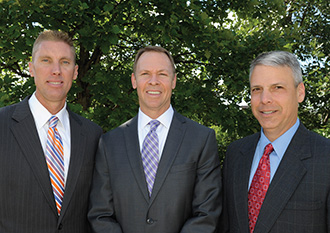
(l-r): Don Gossman, Chief Appraiser; Kevin Pettaway, Vice President-Sales; Mike Peck, Co-Founder; Jeff Sandman, Co-Founder and President of Sales and Marketing; John Whitlow, Vice President-Operations.
NUMBER ONE:
PENDO MANGEMENT GROUP
1st Year
Gross Revenue:
2013: $8,471,671
2010: $212,970
Growth: 3,877.87%
Full-time employees: 14
Take a look at these dots, and see if you can connect them the way Jeff Sandman and Mike Peck did:
• Inflated appraisals contribute to the 2007-08 collapse in the U.S. housing market.
• In May 2009, Fannie Mae and Freddie Mac implement the Home Valuation Code of Conduct, new guidelines for lenders to follow when ordering appraisals.
• Those new standards sever the link between mortgage lender and appraiser, creating opportunities that mortgage appraisal management companies can leverage into new lines of business.
Harder to connect are the dots that led Sandman, whose real estate development and construction company was a victim of the downturn, and Peck, who had recently sold his IT staffing company, to launch Pendo Management Group in 2009. (“Pendo,” by the way, is Latin for “value.”) Their goal—after boning up on the fundamentals of the appraisal business—was to fill a void with concierge-level service using highly certified and tenured appraisers.
“There’s no better time to start something, in theory, than when a market is at the bottom,” Sandman says. “But we’re both entrepreneurs. … We knew nothing about the industry, but we figured it out on our own.” The slow real estate recovery afforded time to absorb the basics and identify the service gaps, so when the market bounced back, they were ready. And how.
With growth of 3,877.87 percent between 2010 and 2013, Pendo Management Group makes a huge splash on its first dive into Ingram’s Corporate Report 100, locking up the No. 1 position this year. “It was a struggle for quite a while,” Sandman says. “In May 2011, we got a client we’d been courting for more than a year, got that contract signed, and that’s when we knew it was going to take off. It just took that one deal ... and clients started coming in droves.”
The goal now, he said, is to continue serving a client roster doing business in all 50 states, by completing the licensing processes in each. That’s an expensive and time-consuming chore, but one that will be key to long-term growth, Sandman said.

(l-r): Co-Owners Dean Shcherbinin, Chief Financial Officer/Chief Operations Officer; Nathan Roberts, CEO; Jon Cross, Chief Marketing Officer.
NUMBER TWO:
AVENUE LINK
1st Year
Gross Revenue:
2013: $6,360,103
2010: $238,697
Growth: 2,564.51%
Full-time employees: 11
Avenue Link makes its CR100 debut in impressive fashion, and in its first year of eligibility. The Lenexa company—which specializes in e-mail marketing management, lead generation and creative development—went from startup in 2010 to $6.36 million in revenues last year. Co-founder Nathan Roberts, who was immersed in both digital marketing fundamentals and fast-growth environments at companies like Clickspeed and Plattform Advertising, says Avenue Link was born of the increased opportunities in an increasingly digital world.
The key to Avenue Link’s success? “Bringing in the right talent early on made a huge difference,” he says. “In our eyes, the only way to grow a successful start-up is with good talent.” With a foothold established, the key now is to keep setting new goals and avoid complacency, Roberts says. “We have to treat every year like we are a start-up, with the mindset that failure is not an option. Each new year has its own challenges, and we treat the entire process as a marathon, not a sprint.”

(l-r): Steve Swanson, Partner; Michael Calloway, Director of Operations; Courtney Kounkel, Partner; Kenneth Bonin, Director of Field Operations; Richard Wetzel, Partner.
NUMBER THREE:
CENTRIC PROJECTS
1st Year
Gross Revenue:
2013: $31,606,199
2010: $1,377,900
Growth: 2,193.79%
Full-time employees: 35
Richard Wetzel, Courtney Kounkel and Steve Swanson left successful careers at prominent contractors to start their own company in 2009—as the construction sector was entering a freefall. But they’re proof that an economy in crisis creates huge, new opportunities: “We had a notion that a company that had the sophisticated processes and deep relationships of a larger construction company but had a flexible and nimble infrastructure and highly efficient cost structure could be successful through the recession and take market share,” Wetzel says. “And when the recession ended, it would be poised for rapid growth.”
Year One was tough, but once Centric started bagging high-profile projects against established competitors, Wetzel says, “we knew we could compete.” The keys, he said, were corporate culture, on-site accountability at their projects, effective use of mobile and cloud-based technology, and an open, highly collaborative workplace. “They were born out of both inspiration and necessity,” he said.

(l-r): Doug Wolff, President, Security Benefit Life; Jackie Fox, VP-Chief Administrative Officer, Security Benefit Corp.; Roger Offermann, Sr. VP-Chief Actuary, Security Benefit Life; Michael Kiley, CEO, Security Benefit Corp.; Anne Trebino, Sr. VP- Human Resources, Security Benefit Corp.; Dave Keith, CEO, se2.
NUMBER FOUR:
SECURITY BENEFIT LIFE INSURANCE
4th Year
Gross Revenue:
2013: $7,007,000,000
2010: $950,000,000
Growth: 637.58%
Full-time employees: 860
Last year, officials at Security Benefit Life Insurance—already riding a growth rocket that made them No. 4 on last year’s CR100— anticipated that statutory revenues could hit $6.5 billion for 2013. Even they didn’t anticipate the boom that was coming, for another spectacular year pushed the revenues of this Topeka company up by 75 percent and past the $7 billion threshold. And that allowed the company to retain that No. 4 slot this year. Among the capital city’s biggest private employers, Security Benefit Life Insurance traces its roots to 1892, and it began introducing retirement products in the 1960s. But not until Michael Kiley became CEO in 2011 did it put a spark to the growth powder keg. Under Kiley’s leadership, the company began to broaden its product lines and aggressively reach out to the Baby Boom market. Security Benefit serves customers in all 50 states and partners with 27,000 licensed and appointed financial planners and representatives with a network of 700 broker/dealers nationwide.

(l-r): Eric Massey, Vice President-Sales; Marti Gooch, CEO; Chris Fricke, Vice President-Operations.
NUMBER FIVE:
THE LOGISTICS STORE
2nd Year
Gross Revenue:
2013: $11,313,959
2010: $1,538,172
Growth: 635.55%
Full-time employees: 12
Last year’s No. 1 is back in the Top 10 this year, still ringing up impressive numbers in Kansas City’s ever-expanding logistics sector. CEO Marti Gooch attributes that to corporate clients who continue to seek out full-service providers capable of managing multiple aspects of their supply chain. “We have continued to expand our services and expertise to meet these needs,” he said. “As capacity continues to tighten, being more aware of company objectives and expectations is imperative. Customers do not like surprises in this area and our focus is to be sure we understand their needs.” New services, including software solutions, have fueled growth with both the existing accounts and new clients, he said, and the company is expanding into new markets. Current conditions suggest more of the same: “We see e-Commerce continuing to grow and see us continuing to grow in this area,” Gooch said. “Our small-package technology as well as focus on warehousing and fulfillment position us well to bring value to those in this sector.”